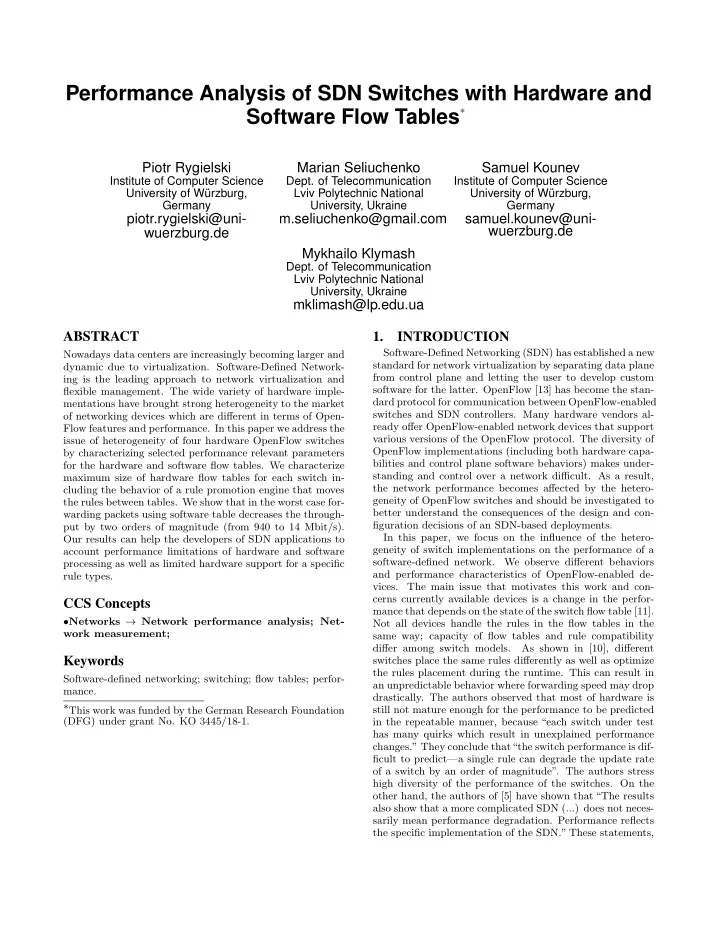

Performance Analysis of SDN Switches with Hardware and Software Flow Tables ∗ Piotr Rygielski Marian Seliuchenko Samuel Kounev Institute of Computer Science Dept. of Telecommunication Institute of Computer Science University of Würzburg, Lviv Polytechnic National University of Würzburg, Germany University, Ukraine Germany piotr.rygielski@uni- m.seliuchenko@gmail.com samuel.kounev@uni- wuerzburg.de wuerzburg.de Mykhailo Klymash Dept. of Telecommunication Lviv Polytechnic National University, Ukraine mklimash@lp.edu.ua ABSTRACT 1. INTRODUCTION Software-Defined Networking (SDN) has established a new Nowadays data centers are increasingly becoming larger and standard for network virtualization by separating data plane dynamic due to virtualization. Software-Defined Network- from control plane and letting the user to develop custom ing is the leading approach to network virtualization and software for the latter. OpenFlow [13] has become the stan- flexible management. The wide variety of hardware imple- dard protocol for communication between OpenFlow-enabled mentations have brought strong heterogeneity to the market switches and SDN controllers. Many hardware vendors al- of networking devices which are different in terms of Open- ready offer OpenFlow-enabled network devices that support Flow features and performance. In this paper we address the various versions of the OpenFlow protocol. The diversity of issue of heterogeneity of four hardware OpenFlow switches OpenFlow implementations (including both hardware capa- by characterizing selected performance relevant parameters bilities and control plane software behaviors) makes under- for the hardware and software flow tables. We characterize standing and control over a network difficult. As a result, maximum size of hardware flow tables for each switch in- the network performance becomes affected by the hetero- cluding the behavior of a rule promotion engine that moves geneity of OpenFlow switches and should be investigated to the rules between tables. We show that in the worst case for- better understand the consequences of the design and con- warding packets using software table decreases the through- figuration decisions of an SDN-based deployments. put by two orders of magnitude (from 940 to 14 Mbit/s). In this paper, we focus on the influence of the hetero- Our results can help the developers of SDN applications to geneity of switch implementations on the performance of a account performance limitations of hardware and software software-defined network. We observe different behaviors processing as well as limited hardware support for a specific and performance characteristics of OpenFlow-enabled de- rule types. vices. The main issue that motivates this work and con- cerns currently available devices is a change in the perfor- CCS Concepts mance that depends on the state of the switch flow table [11]. • Networks → Network performance analysis; Net- Not all devices handle the rules in the flow tables in the work measurement; same way; capacity of flow tables and rule compatibility differ among switch models. As shown in [10], different Keywords switches place the same rules differently as well as optimize the rules placement during the runtime. This can result in Software-defined networking; switching; flow tables; perfor- an unpredictable behavior where forwarding speed may drop mance. drastically. The authors observed that most of hardware is ∗ This work was funded by the German Research Foundation still not mature enough for the performance to be predicted (DFG) under grant No. KO 3445/18-1. in the repeatable manner, because “each switch under test has many quirks which result in unexplained performance changes.” They conclude that“the switch performance is dif- ficult to predict—a single rule can degrade the update rate of a switch by an order of magnitude”. The authors stress high diversity of the performance of the switches. On the other hand, the authors of [5] have shown that “The results also show that a more complicated SDN (...) does not neces- sarily mean performance degradation. Performance reflects the specific implementation of the SDN.” These statements,
Recommend
More recommend